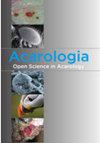消毒效果显著:螺氯芬对荨麻疹叶螨(螨亚纲:叶螨科)防治效果的人口统计学分析
IF 0.9
3区 农林科学
Q3 ENTOMOLOGY
引用次数: 0
摘要
Spirodiclofen的特点是对二斑蛛(Acari:Tetranychidae Koch)的成年雌性具有相对缓慢的杀螨作用,降低了它们的繁殖力(产卵/雌性)和生育能力(孵化/雌性)。考虑到年轻雌性的高繁殖率对该定植物种的种群生物学至关重要,产卵前的白蚁雌性暴露于杀螨剂可能会影响种群增长。使用基于繁殖力和基于繁殖能力的变体构建的年龄阶段二性生活表,在人口统计学生物测定中评估了螺双氯芬对二斑蝶生活史特征和种群参数的影响。杀螨剂以九种浓度对产卵前的雌性进行施用,从推荐的田间施用量(96 mg/l)开始。浓度在12-96毫克/升之间的处理显著降低了繁殖力和寿命,而27-40%的雌性没有产卵。暴露对2-21%的雌性是致命的,其中绝大多数没有产卵。相当一部分存活的雌性在治疗后的前四天内(对照组中约50%的卵子产下)也未能产卵,即它们被杀螨剂消毒。与此同时,死亡女性的比例上升到17-55%,主要是由于绝育女性的死亡。与对照组相比,三种最高浓度(24-96 mg/l)显著降低了净繁殖率(R0)、固有增长率(r)和有限增长率(λ),分别降低了49-72%、20-34%和4-6%。这种减少主要是由于绝育和接受治疗的雌性死亡率高,再加上生殖后代的繁殖力和寿命降低。应用基于生育能力的生命表显示,在三个最高浓度的处理中,r和λ显著降低(与对照相比分别降低了23-40%和4-7%)。与基于繁殖力的生命表获得的参数相比,在基于繁殖能力的生命表中观察到的短暂的经卵毒性效应不足以导致种群参数的显著降低。本文章由计算机程序翻译,如有差异,请以英文原文为准。
Sterilization makes a difference: demographic analysis of spirodiclofen effects on Tetranychus urticae (Acari: Tetranychidae)
Spirodiclofen is characterized by a relatively slow acaricidal action against adult females of the two-spotted spider mite, Tetranychus urticae Koch (Acari: Tetranychidae), with reduction of their fecundity (eggs laid/female) and fertility (eggs hatched/female). Exposure of pre-ovipositing T. urticae females to the acaricide may affect population growth, considering that a high reproduction of young females is crucial in the population biology of this colonizing species. Effects of spirodiclofen on life-history traits and population parameters of T. urticae were evaluated in demographic bioassay using the age-stage two-sex life table, constructed in fecundity-based and fertility-based variants. The acaricide was applied against pre-ovipositing females in a series of nine concentrations, starting from the recommended field rate (96 mg/l). The treatments with concentrations ranging from 12 - 96 mg/l significantly reduced fecundity and longevity, while 27 - 40% of females didn’t lay eggs. Exposure was lethal to 2 - 21% of the females, of whom a large majority didn’t lay eggs. A considerable part of surviving females also failed to lay eggs within the first four post-treatment days (when around 50% of all eggs in the control were laid) i.e., they were sterilized by the acaricide. At the same time, the percentage of dead females rose to 17 - 55%, mainly due to the mortality of sterilized females. The three highest concentrations (24 – 96 mg/l) significantly reduced the net reproductive rate (R0), intrinsic rate of increase (r) and finite rate of increase (λ), by 49-72%, 20-34%, and 4-6%, respectively, compared to the control. This reduction was mainly the result of sterilization and high mortality of treated females, in combination with reduced fecundity and longevity of reproductive ones. Application of the fertility-based life table showed significant decrease of r and λ (by 23-40%, and 4-7%, respectively, compared to the control), in the treatments with the three highest concentrations. The short-lived transovarial toxic effect observed in the fertility-based life table was not sufficient to cause a significant reduction in population parameters, compared to those acquired by the fecundity-based life table.
求助全文
通过发布文献求助,成功后即可免费获取论文全文。
去求助
来源期刊

Acarologia
ENTOMOLOGY-
CiteScore
2.00
自引率
18.20%
发文量
81
期刊介绍:
Acarologia is a free open-access journal. Please help us by submitting manuscripts in accordance with following instructions.
All manuscripts which do not conform to the instructions will be returned to authors without the benefit of review.
Acarologia publishes the results of original research on all aspects of Acarology.
The journal policy is that taxonomic descriptions should include several species within a same genus/family, when possible.
The editors reserve the right to refuse manuscripts when authors intentionally divide individual species descriptions of the same genus/family into distinct publications.
Single species descriptions should be clearly justified based on their scientific interest.
 求助内容:
求助内容: 应助结果提醒方式:
应助结果提醒方式:


